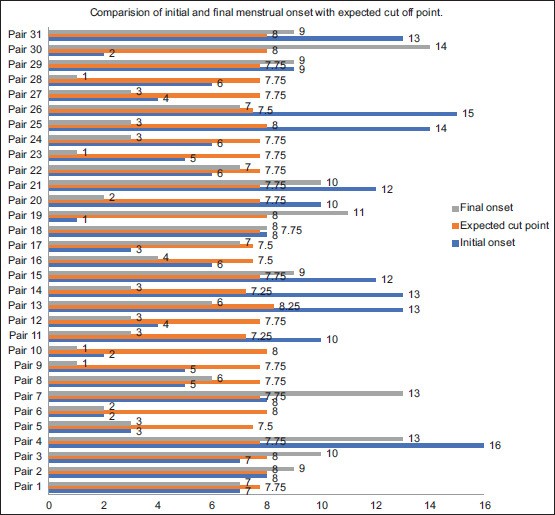Menstrual synchrony, often called the McClintock effect, is the alleged phenomenon where women living in close proximity experience a convergence in their menstrual cycles. But does it really happen, and if so, why? This article explores the science behind menstrual synchrony, examining the evidence and potential explanations for this intriguing phenomenon.
 Figure 1: Comparison of initial and final menstrual onset with expected cut-off point
Figure 1: Comparison of initial and final menstrual onset with expected cut-off point
The History and Controversy of Menstrual Synchrony
The concept of menstrual synchrony gained prominence with a 1971 study by Martha McClintock, observing menstrual convergence among college roommates. While initial research seemed to support this phenomenon, subsequent studies yielded conflicting results, sparking debate within the scientific community. Some research confirmed synchrony in specific groups like close friends or co-workers, while others found no significant patterns in lesbian couples or larger populations. This inconsistency raises questions about the validity and prevalence of menstrual synchrony.
Potential Explanations: Pheromones and Social Factors
One prominent theory suggests that pheromones, airborne chemical signals, play a crucial role in menstrual synchrony. These chemicals, potentially present in sweat, could influence hormonal cycles and ovulation timing in women exposed to them. Studies have explored the impact of specific pheromones like androstenol and androstenone on menstrual cycles, with some suggesting a link between pheromone sensitivity and synchronization. However, the precise pheromone responsible for this effect, if it exists, remains unidentified.
Beyond pheromones, social and environmental factors might contribute to apparent menstrual synchrony. Shared stress, similar diets, and synchronized sleep schedules could indirectly influence hormonal rhythms, potentially leading to menstrual convergence. The strength of social bonds and the amount of time women spend together might also play a role, with closer friendships correlating with higher synchrony rates.
Debunking the Myth: Statistical Artifacts and Chance
Critics of menstrual synchrony argue that observed convergence could be due to statistical artifacts and random chance. With varying cycle lengths and the probability of overlap, some degree of synchrony is statistically inevitable. Furthermore, small sample sizes and biases in study design can skew results, leading to false positives. Without rigorous methodology and large-scale studies, isolating a genuine synchrony effect from random occurrences proves challenging.
The Current Consensus: More Research Needed
The scientific consensus on menstrual synchrony remains inconclusive. While pheromones and social factors offer plausible explanations, definitive proof remains elusive. Methodological limitations in past research and the potential for statistical artifacts necessitate further investigation with larger, more controlled studies. Future research should focus on identifying specific pheromones, controlling for confounding variables, and employing robust statistical analyses to determine the true prevalence and underlying mechanisms of menstrual synchrony.
Table 1: Anthropometric characteristics of study population
Table 2: One-sample t-test for menstrual cycle synchrony assessment
Implications and Future Directions
Understanding menstrual synchrony has implications for reproductive health, family planning, and our understanding of human social behavior. If confirmed, it could lead to new insights into hormonal regulation and potential therapeutic interventions. However, until more robust evidence emerges, menstrual synchrony remains an intriguing but unproven phenomenon, highlighting the complexity of human biology and the need for continued scientific inquiry. Further research could explore the interplay of genetics, environment, and social dynamics in shaping menstrual cycles and potentially uncover the mystery of why some women’s periods seem to sync.

